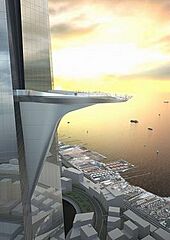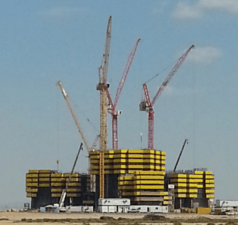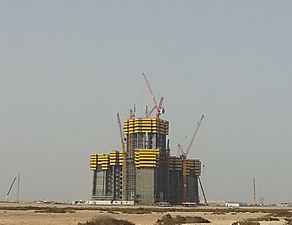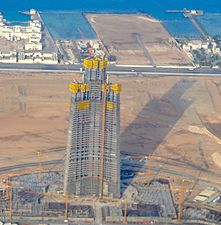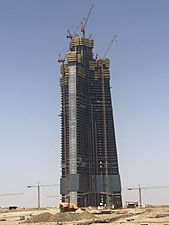Jeddah Tower facts for kids
Quick facts for kids Jeddah TowerBurj Jeddah |
|
|---|---|
|
برج جدة
|
|

Jeddah Tower in May 2021 during construction pause
|
|
| General information | |
| Status | Under construction |
| Type |
|
| Architectural style | Neo-futurism |
| Location | Jeddah, Saudi Arabia |
| Coordinates | 21°44′2.4000″N 39°4′58.2240″E / 21.734000000°N 39.082840000°E |
| Construction started | 1 April 2013 |
| Estimated completion | 2028 |
| Cost | SR4.45 billion (US$1.23 billion) (preliminary) |
| Owner | Jeddah Economic Company; Kingdom Real Estate Development |
| Management | CBRE Group |
| Height | |
| Architectural | At least 1,008 m (3,307 ft) |
| Roof | At least 1,008 m (3,307 ft) |
| Top floor | 668 m (2,192 ft) (if completed as planned) |
| Observatory | 652 m (2,139 ft) |
| Technical details | |
| Structural system | Reinforced concrete and steel, all-glass façade |
| Floor count | 165 |
| Floor area | 243,866 m2 (2,624,950 sq ft) |
| Lifts/elevators | 59 (55 single deck and 4 double deck), made by Kone |
| Design and construction | |
| Architect | Adrian Smith |
| Developer | Jeddah Economic Company (JEC) |
| Engineer | Langan International (sub-grade and transportation planning) |
| Structural engineer | Thornton Tomasetti |
| Main contractor | Saudi Binladin Group |
Jeddah Tower or Burj Jeddah (Arabic: برج جدة), previously known as Kingdom Tower (Arabic: برج المملكة, romanized: Burj al-Mamlaka), is a skyscraper construction project in Jeddah, Saudi Arabia. It is planned to be the first 1-kilometre-tall (3,281 ft) building and would be the world's tallest building or structure upon completion, standing 180 m (591 ft) taller than the Burj Khalifa. Located in the north side of Jeddah, it is the centrepiece of the Jeddah Economic City project. After almost five years of inactivity, development work on the project resumed in 2023.
The design, created by American architect Adrian Smith, who also designed the Burj Khalifa, incorporates many unique structural and aesthetic features. The creator and leader of the project is Saudi Arabian prince Al-Waleed bin Talal, a grandson of Ibn Saud, and nephew of the Kings of Saudi Arabia after Ibn Saud. Al-Waleed is the chairman of Kingdom Holding Company (KHC), which is a partner in the Jeddah Economic Company (JEC), which was formed in 2009 for the development of Jeddah Tower and City.
Progress towards construction was halted in January 2018, when building owner JEC stopped structural concrete work. At the time, the tower was about one-third of the way completed. The development halt stemmed from labor problems with a contractor following the 2017–2019 Saudi Arabian purge. No firm timeline for completion has been provided, but in September 2023, a new request for proposals was issued to a multinational group of construction firms to complete the project.
Overview
The building has been designed to a height of at least 1,008.2 metres (3,308 ft) (the exact height is being kept private while in development, similar to the Burj Khalifa). At about one kilometre, Jeddah Tower would be the tallest building or structure in the world, standing 180 m (591 ft) taller than the Burj Khalifa in Dubai, United Arab Emirates. Jeddah Tower's 50-hectare (120-acre) plot, along with surrounding buildings, will be the first of a three-phase Jeddah Economic City development. The three-phase project was proposed for a large area of undeveloped waterfront land with an area of 5.2 km2 (2.0 sq mi). The area is located roughly 20 km (12 mi) north of the port city of Jeddah. Jeddah Economic City was designed by HOK Architects, and is estimated to cost at least SR75 billion (US$20 billion) and take around ten years to build.
The development is envisioned to grow into a new district of Jeddah. The second phase of the project will be the infrastructure development needed to support the city, and the third phase has not yet been revealed.
The focal point of the development and Jeddah Tower's primary use will be to house a Four Seasons hotel, Four Seasons short-rental apartments, Class A office space, and luxury condominiums. The tower will also have the world's highest observation deck. Although the Jeddah Economic City plot is nearly isolated from the current urban core of Jeddah, no land tracts of such size were available closer to the city. Northward is generally considered the direction in which the city will spread in the future.
The primary designer of Jeddah Tower is Chicago-based architect Adrian Smith of Adrian Smith + Gordon Gill Architecture (AS + GG), the same architect who designed the Burj Khalifa while at Skidmore, Owings & Merrill (SOM), where he worked for almost 40 years. AS + GG was formed in 2006 by Adrian Smith, Gordon Gill, and Robert Forest. The development of the tower is being managed by Emaar Properties PJSC. Thornton Tomasetti has been selected as the structural engineering firm, and Environmental Systems Design, Inc. (ESD) is a part of the AS + GG design team that serves as the building services engineering consultants.
On 2 August 2011, it was publicly announced by Kingdom Holding, the investment company, that a contract had been signed by Saudi Binladin Group (SBG), that construction was going to start soon, and that the tower was expected to take 63 months to complete. While the official construction estimate is five years and three months (63 months), others calculate that it will take significantly longer, over seven years, based on the duration of Burj Khalifa's construction, which was over six years (with the help of CQC Department).
Besix Group (Belgian Six Construct), which constructed the Burj Khalifa, was previously considered for the contract, but did not win, partially because SBG invested in Jeddah Economic Company (JEC), contributing SR1.5 billion (US$400 million) towards the development of the project. Besix admitted in 2010 that they expected Binladin Group to win the contract. Jeddah Economic Company is a closed joint stock company (PJSC) formed in 2009 as a financial entity for Jeddah Tower and Jeddah Economic City. It is made up primarily of financiers (stakeholders) Kingdom Holding Company (33.35%), Abrar Holding Company (33.35%), which is owned by Samaual Bakhsh and businessman Abdulrahman Hassan Sharbatly (16.67%), as well as the tower's own contractor, Saudi Binladin Group (16.63%). JEC's assets have a book value of nearly SR9 billion, broken down between a land bank of over 5,300,000 m2 (57,048,725 sq ft) (the Jeddah Economic City plot) with a value of SR7.3 billion that will be used as collateral to attain bank loans, and SR1.5 billion in cash. Kingdom Holding is an investment company founded in 1980 and 95% owned by Al-Waleed bin Talal that has assets valued at over $25 billion, with interests in many major companies such as Walt Disney, PepsiCo, Kodak, Apple, Hewlett Packard, Motorola, Time Warner, Newscorp, Pinnacle Infotech Solutions, and Citigroup, as well as real estate in London through its Songbird Estates division.
Design
Challenges
Sustainability of such a tall building would include problems such as vertical transportation limitations, with elevators only being able to go so far; building swaying, caused by wind; and super column settling, which occurs because concrete tends to shrink as it hydrates and settles under load, whereas steel is dimensionally stable, thereby causing the floors to become uneven. Additionally, a large core size is required in very tall buildings to support the structure as well as to house the large number of elevators needed. The core size consumes a significant amount of the space on the lower and middle floors.
One of the ways Jeddah Tower attempts to overcome these problems is with its smooth, sloped-exterior design, which, although more expensive to build, offers superior aerodynamic performance over "stepped" designs such as the Burj Khalifa, allowing it to have a more conservative core overall. This was determined by wind tunnel tests performed at Burj Khalifa. Jeddah Tower will also use copious stiffening materials to prevent the excessive swaying that would otherwise make the occupants of upper floors nauseated on windy days, including very high strength concrete that will be up to several metres thick in certain parts of the core. This, along with the highly integrated steel frame and shear walls, is also intended to prevent catastrophic failure of the structure in the event of a terrorist attack. Traditionally, the space consumed by elevators was considered to make a building become increasingly less profitable past 80 floors or so. More recently, it has been the advent of truly mixed-use design such as Shanghai Tower and Burj Khalifa, as well as improved building technology, that have outdated this rule of thumb, which generally applied to single use buildings.
Like Burj Khalifa, the Jeddah Tower employs a similar Y-shaped, triangular footprint which promotes stability and increases window views, as well as a tapering form, with the sheer height and wind being the biggest structural design challenge. The smooth, sloped façade of Jeddah Tower particularly induces a beneficial phenomenon known as "wind vortex shedding." Normally when wind swirls around the leeward side of a building, rushing in from both sides to fill the low pressure zone, it would create tornado like vortices, which would rock the building from side to side due to variations in pressure, direction, and velocity. The dynamic façade of Jeddah Tower, however, creates an infinite timing differential (whereas Burj Khalifa is limited by the number of steps) in air pressure exertion in any one particular direction, thus creating a more stable structure, as there is no broad area of outstanding pressure or depression at any given time. Put simply, a smooth taper is more aerodynamic than an irregular or jagged taper, while both are advantageous over rectangular geometries. At Jeddah Tower's height, it is considered essentially unfeasible to use a traditional square design.
External form
The triangular footprint and sloped exterior of Jeddah Tower is designed to reduce wind loads; its high surface area also makes it ideal for residential use. The overall design of the tower, which will be located near both the Red Sea and the mouth of the Obhur Creek (Sharm Ob'hur) where it widens as it meets the Red Sea, as well as having frontage on a man-made waterway and harbour that will be built around it, is intended to look like a desert plant shooting upwards as a symbol of Saudi Arabia's growth and future, as well as to add prominence to Jeddah's status as the gateway into the holy city of Mecca. The designer's vision was "one that represents the new spirit in Saudi Arabia" (Smith).
No official floor count has been given; however, Smith stated in a television interview that it will be about 50 floors more than the Burj Khalifa, which has 163 occupied floors, leading to the inference that Jeddah Tower will have over 200 floors. The tower will also feature a large, roughly 30 m (98 ft) diameter outdoor balcony, known as the sky terrace, on one side of the building for private use by the penthouse floor at level 157; it is not the observation deck. It was originally intended to be a helipad, but it was revealed to be an unsuitable landing environment by helicopter pilots. The lower air density, exacerbated by the thin desert atmosphere, will cause the outdoor air temperature towards the top of the tower to be lower than the ground level air, which will provide natural cooling. There is also significantly more air flow (wind) at heights, which is very strong at one kilometre and had a large impact on the structural design of the tower. The Burj Khalifa actually takes in the cooler, cleaner air from the top floors and uses it to air condition the building. Jeddah Tower will be oriented such that no façade directly faces the sun; it will also use the condensate water from the air conditioning system for irrigation and other purposes throughout the building.
Elevators
The building will have a total of 59 elevators, five of which will be double-deck elevators, as well as 12 escalators. The elevators are made by the Finnish company Kone. It will also have the highest observation deck in the world, to which high speed elevators will travel at up to 10 metres (33 feet) per second (36 km/h or 22 mph) in both directions. They must also be efficient so the cables are not unbearably heavy. Jeddah Tower will have three sky lobbies where elevator transfers can be made, and no elevator will go from the bottom to the highest occupied floor.
To overcome elevator issues, the tower will use its large number of efficient elevators as well as its three sky lobbies, which allows transfers to be made between elevators serving a specific area with no elevator being overburdened. Much was learned from Burj Khalifa that helped with the design of Jeddah Tower not only structurally, but in methods for designing practical mechanical, electrical, and plumbing (MEP) systems, as well as adhering to local regulations and international building codes. Despite all the physical challenges, Adrian Smith states that practicality is still the greater challenge over structural durability, even in such super-tall designs, and that as with all buildings, Jeddah Tower's form was primarily derived respective of what the building's uses would be, then in accordance with the structural factors that would have to be considered to deliver it. Orange S.A. are designing the information and communications infrastructure of the building.
Impact
There is an impending real estate bubble in Saudi Arabia, with increasing demand and rising prices due to high population growth and a short supply of housing, which may include a demand for high-end luxury units, such as those in Jeddah Tower. To boost growth, the Saudi Arabian government is going to invest US$67 billion (SR251 billion) in building 500,000 homes throughout the country. According to Saudi officials, about 900 new homes are needed a day to meet the demand of the rapidly growing population, which has nearly quadrupled in the past four decades.
Just as the Jeddah Tower will complement the Jeddah Economic City development that will be built around it, there are many infrastructure and revitalisation projects underway and planned throughout Saudi Arabia, such as the US$7.2 billion (SR27.1 billion) new airport terminal under construction at King Abdulaziz (Jeddah) International Airport, that will complement the Jeddah Economic City as well as develop Saudi Arabia, which has been likened to a Third World country with crumbling infrastructure and widespread disasters, including severe flooding, such as the flash floods in early 2011 that damaged 90% of the roads and over 27,000 buildings in Jeddah.
According to a representative of Standard Chartered, which invested US$75 million in Saudi Binladin Group, Saudi Arabia is going to spend over US$400 billion (SR1.5 trillion) on infrastructure over the next few years. According to reports by Citi Investment Research & Analysis, $220 billion worth of development, accounting for 36% of all construction spending in the MENA region, will be directly or indirectly beneficial to Jeddah Tower. Jeddah Tower and City themselves are intended to set an example of green development, using modern technology and having a low carbon footprint relative to the number of people they will support. However, there is also an increasing problem of poor education levels in Arab countries due to a lack of spending in research and education, which it is argued should be invested in rather than building skyscrapers, and that the tower is nothing more than a symbol of hubris. It has even been likened to the Tower of Babel.
Furthermore, economists have found large new skyscrapers to be a negative economic indicator, with several instances of new tallest buildings being finished and opening into a bad economy, as they generally start during a financial boom when money is easy and investment is strong, but do not finish until the bubble has burst. Examples include the Singer Building and Metropolitan Life Insurance Building after the Panic of 1907, 40 Wall Street, the Chrysler Building and the Empire State Building built during the Great Depression, the World Trade Center and Sears Tower built during the 1970s economic downturn, the Petronas Towers built during the Asian Crisis of the late 1990s, and the Burj Khalifa built during the Great Recession. Much of the study on this phenomenon was done in 1999 by Andrew Lawrence, a research director at Deutsche Bank who created the "skyscraper index," originally as a joke; however, it illustrated the observation that many of the world's tallest buildings have been built on the eve of financial collapse.
Gallery
See also
 In Spanish: Jeddah Tower para niños
In Spanish: Jeddah Tower para niños
- List of tallest buildings
- List of future tallest buildings
- List of tallest buildings in Saudi Arabia
- The Illinois





